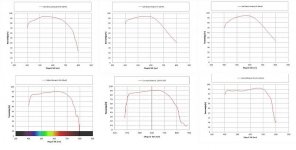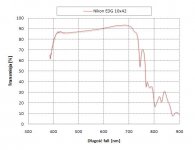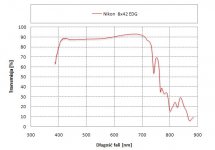eitanaltman
Well-known member
^^^ I wish Gijs showed graphs (or at least published the tables of data) that go beyond ~450nm on the blue end and ~675nm on the red end. I understand that these capture the majority of the visible spectrum and especially those wavelengths to which we are maximally sensitive, but if they were 400-750 instead of 450-675 I think you'd see even more of a gap at the extremes
Assuming Allbinos spectrum graphs are at all trustworthy (even if not precise, they should be at least directionally accurate), they show a broader range that covers beyond the limits of the visual spectrum.
I made a quick composite of three Zeiss T* bins across the top (Conquest HD, Victory HT, Victory SF) and then Nikon Monarch HG and Leica UVHD and UVHD+ on the bottom.
All the measurements seem to show a similar trend where Zeiss transmission spectra show more of a "dome" shape with a very high center peak in the vicinity of ~550nm, and broadly sustain very high transmission from ~475-625nm. All good stuff that should yield bright views with excellent, balanced color for MOST things.
However the Zeiss bins all begin sloping downhill above ~575nm (something which Gijs' data corroborates), and have fallen off a cliff by 700nm. The Leica/Nikon high end models are "tilted" towards the red, but the overall spectra seems flatter and broader, especially at the red end where they don't hit their peak until ~650nm and maintain strong transmission out to 700nm and beyond.
I think that's where the magic happens with the deep red tones + the overall impression of depth/contrast from covering a broader color gamut. You may not notice it depending on what you're looking at, and it may not have a huge impact on "brightness", but I think the more complete coverage of the visual spectrum is what gives Leica (and, to a lesser extent, Nikon) their characteristic saturated, rich, contrasty feel. Older Leicas were way behind on the blue/green end though, which is why they also had a more "cream/warm" tone... but the UVHD/HD+ coatings have steadily improved things over time so the deficit below 600nm has shrunk, while their advantage >600nm is still there.
When I compare my 2012-2015 Trinovid (UV BR level coatings) to my UVHD, the deep blue tones have more of a "dingy" tinge to them whereas the UVHD blues feel deeper and more saturated, which also makes whites whiter (not as warm/creamy). I tend to feel that binoculars that have good overall transmission but don't have that oomph on the far red end feel a wee bit "colder, "flatter", and more "sterile". What do I know though :smoke:
EDIT: and for completeness, it appears that the best Swaros with recent coatings sort of split the difference, with peak transmission perhaps a hair lower than the Zeiss but a flatter shape, with high transmission maintained farther into the blue/red extremes (although the red end still lags behind Leica). I always perceive Swaros to be exceedingly neutral and and "accurate", with perhaps a touch of coolness or "analytical" feel compared to Leicas. This shows well in the Swaro SV vs Leica NV vs Zeiss SF graph from Gijs posted above... the Swaro SV has a clear advantage <500nm, and the spectrum is very flat all the way up to ~625nm. The Zeiss SF pulls a wee bit ahead in the ~550nm zone, but falls off more steeply than the Swaro SV above 600nm. The Leica NV (and, side note, but that graph made my jaw drop!) does not fall off >600nm, maintaining very high transmission (>90%) out to the right edge of the graph (~675nm) whereas both the Zeiss SF and Swaro SV have dropped to ~80%.
Assuming Allbinos spectrum graphs are at all trustworthy (even if not precise, they should be at least directionally accurate), they show a broader range that covers beyond the limits of the visual spectrum.
I made a quick composite of three Zeiss T* bins across the top (Conquest HD, Victory HT, Victory SF) and then Nikon Monarch HG and Leica UVHD and UVHD+ on the bottom.
All the measurements seem to show a similar trend where Zeiss transmission spectra show more of a "dome" shape with a very high center peak in the vicinity of ~550nm, and broadly sustain very high transmission from ~475-625nm. All good stuff that should yield bright views with excellent, balanced color for MOST things.
However the Zeiss bins all begin sloping downhill above ~575nm (something which Gijs' data corroborates), and have fallen off a cliff by 700nm. The Leica/Nikon high end models are "tilted" towards the red, but the overall spectra seems flatter and broader, especially at the red end where they don't hit their peak until ~650nm and maintain strong transmission out to 700nm and beyond.
I think that's where the magic happens with the deep red tones + the overall impression of depth/contrast from covering a broader color gamut. You may not notice it depending on what you're looking at, and it may not have a huge impact on "brightness", but I think the more complete coverage of the visual spectrum is what gives Leica (and, to a lesser extent, Nikon) their characteristic saturated, rich, contrasty feel. Older Leicas were way behind on the blue/green end though, which is why they also had a more "cream/warm" tone... but the UVHD/HD+ coatings have steadily improved things over time so the deficit below 600nm has shrunk, while their advantage >600nm is still there.
When I compare my 2012-2015 Trinovid (UV BR level coatings) to my UVHD, the deep blue tones have more of a "dingy" tinge to them whereas the UVHD blues feel deeper and more saturated, which also makes whites whiter (not as warm/creamy). I tend to feel that binoculars that have good overall transmission but don't have that oomph on the far red end feel a wee bit "colder, "flatter", and more "sterile". What do I know though :smoke:
EDIT: and for completeness, it appears that the best Swaros with recent coatings sort of split the difference, with peak transmission perhaps a hair lower than the Zeiss but a flatter shape, with high transmission maintained farther into the blue/red extremes (although the red end still lags behind Leica). I always perceive Swaros to be exceedingly neutral and and "accurate", with perhaps a touch of coolness or "analytical" feel compared to Leicas. This shows well in the Swaro SV vs Leica NV vs Zeiss SF graph from Gijs posted above... the Swaro SV has a clear advantage <500nm, and the spectrum is very flat all the way up to ~625nm. The Zeiss SF pulls a wee bit ahead in the ~550nm zone, but falls off more steeply than the Swaro SV above 600nm. The Leica NV (and, side note, but that graph made my jaw drop!) does not fall off >600nm, maintaining very high transmission (>90%) out to the right edge of the graph (~675nm) whereas both the Zeiss SF and Swaro SV have dropped to ~80%.
Attachments
Last edited:







